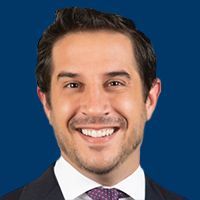Urelumab Induces Additive Benefit With Vaccine/Nivolumab Combo in Pancreatic Cancer
November 13, 2020 – The addition of urelumab, an anti-CD137 agonist to the GVAX vaccine and nivolumab led to a 30% pathologic response rate and was associated with mild toxicity as neoadjuvant or adjuvant therapy in patients with resectable pancreatic ductal adenocarcinoma.
Lei Zheng, MD, PhD

The addition of urelumab, an anti-CD137 agonist to the GVAX vaccine and nivolumab (Opdivo) led to a 30% pathologic response rate and was associated with mild toxicity as neoadjuvant or adjuvant therapy in patients with resectable pancreatic ductal adenocarcinoma (PDAC), according to findings from a 3-arm phase 1/2 trial (NCT02451982) that were presented during the virtual 2020 SITC Annual Meeting.
The 3 pathologic responses were moderate per the College of American Pathologists grade 2 criteria. Nine patients remain disease free after a median follow-up of 12 months.
“[This is a] preliminary sign of the antitumor efficacy [of the regimen], wrote Lei Zheng, MD, PhD, lead author, and professor of oncology and surgery at Johns Hopkins University School of Medicine, and co-authors, in the poster. “The immune and clinical efficacy of anti-CD137 agonist-based combinations warrant further investigation.”
The GVAX vaccine is an allogeneic pancreatic cancer cell vaccine that expresses GM-CSF. The off-the-shelf product, which was produced at Johns Hopkins University Good Manufacturing Practice, is safe but has modest activity as a single agent.
Urelumab is a fully human anti-CD137 agonist immunoglobulin G4 monoclonal antibody. In mouse models, the immune co-stimulatory molecule CD137 within the tumor microenvironment remained inactivated after vaccine-induced T-cell and PD-1 inhibition. Supported by additional preclinical study, investigators theorized that the addition of the anti-CD137 agonist urelumab could provide synergistic benefit.
The trial consists of 3 arms: GVAX alone (arm A), GVAX plus nivolumab (arm B), and GVAX plus nivolumab and urelumab (arm C).
Eligible patients were at least 18 years of age, had R0/R1 resection, radiographic evidence of resectable pancreatic ductal adenocarcinoma, no prior anti-cancer treatment, no active autoimmune disease, and adequate hematologic, renal, and hepatic functions.
An increase in intratumoral CD137+ and CD8+ T cells served as the primary objective of the study. Evaluation of safety, overall survival, disease-free survival, and other immune parameters served as secondary end points.
In arm A, patients received 200 mg/m2 of cyclophosphamide intravenously (IV) on day 0 and 5 x 108 cells of the GVAX vaccine intradermally on day 1 two weeks prior to surgery, 6 to 10 weeks following surgery, and every 4 weeks for 4 cycles after adjuvant chemotherapy.
In arm B, patients received 200 mg/m2 of cyclophosphamide and 480 mg of nivolumab IV on day 0 and 5 x 108 cells of the GVAX vaccine intradermally on day 1 two weeks prior to surgery, 6 to 10 weeks following surgery, and every 4 weeks for 4 cycles after adjuvant chemotherapy.
In arm C, patients received nivolumab IV at a dose of 480 mg plus 8 mg of IV urelumab and 200 mg/m2 of IV cyclophosphamide on day 0 two weeks prior to surgery, 6 to 10 weeks following surgery, and every 4 weeks for 4 cycles after adjuvant chemotherapy. The GVAX vaccine was administered intradermally on day 1.
Between February 2019 and August 2020, 10 evaluable patients were enrolled and underwent R0 resection. All 10 patients received at least 2 cycles of the study regimen. No surgical delay because of treatment toxicity was reported.
Toxicities were mild and consisted of grade 1 vomiting (n = 2), fatigue (n = 4), flu-like symptoms (n = 2), arthritis (n = 1), grade 1/2 nausea (n = 7) and periorbital edema without pruritus around the eyes (n = 1), and grade 2 abdominal pain (n = 1), anorexia (n = 1), diarrhea (n = 1), thyroiditis (n = 1), pruritus (n = 3), peripheral sensory neuropathy (n = 1), and increased liver function tests (n = 1). Two cases of grade 3 rash were also reported (n = 2), which responded quickly to oral steroids and did not recur after re-dosing.
“Previous observations of liver toxicity with urelumab or other T-cell agonists and severe immune-related adverse effects were not observed in this trial, suggesting urelumab is safe as neoadjuvant/adjuvant therapy in this resectable PDAC patient population,” concluded the study authors.
Reference
- Urelumab (anti-CD137 agonist) in combination with vaccine and nivolumab treatments is safe and associated with pathologic response as neoadjuvant and adjuvant therapy for resectable pancreatic cancer. Presented at: 2020 SITC Annual Meeting; November 9-14, 2020; virtual. Abstract 812.



